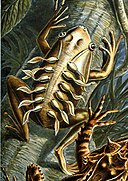Fasciculus:Haeckel Batrachia.jpg

Mensura huius perspectionis: 424 × 599 elementa imaginalia. Aliae mensurae: 170 × 240 elementa imaginalia | 339 × 480 elementa imaginalia | 543 × 768 elementa imaginalia | 724 × 1 024 elementa imaginalia | 2 323 × 3 284 elementa imaginalia.
Sua resolutio (2 323 × 3 284 elementa imaginalia, magnitudo fasciculi: 2.17 megaocteti, typus MIME: image/jpeg)
Historia fasciculi
Presso die vel tempore fasciculum videbis, sicut tunc temporis apparuit.
| Dies/Tempus | Minutio | Dimensiones | Usor | Sententia | |
|---|---|---|---|---|---|
| recentissima | 03:17, 24 Februarii 2006 |  | 2 323 × 3 284 (2.17 megaocteti) | Ragesoss | improve version, based on same original scan |
| 00:22, 11 Februarii 2006 |  | 2 318 × 3 280 (2.21 megaocteti) | Ragesoss | The 68th plate from Ernst Haeckel's 1899 ''Kunstformen der Natur'', depicting frogs classified as Batrachia. Category:Ernst Haeckel |
Nexus ad fasciculum
Ad hunc fasciculum nectit:
Usus fasciculi per inceptus Vicimediorum
Quae incepta Vici fasciculo utuntur:
- Usus in arz.wikipedia.org
- Usus in ast.wikipedia.org
- Usus in az.wikipedia.org
- Usus in ban.wikipedia.org
- Usus in be.wikipedia.org
- Usus in bg.wikipedia.org
- Usus in ca.wikipedia.org
- Usus in ca.wikibooks.org
- Usus in ceb.wikipedia.org
- Usus in ckb.wikipedia.org
- Usus in dag.wikipedia.org
- Usus in de.wikipedia.org
- Usus in din.wikipedia.org
- Usus in el.wikipedia.org
- Usus in en.wikipedia.org
- Wikipedia:Featured pictures thumbs/04
- Wikipedia:Picture of the day/June 2006
- User:Ragesoss/Haeckel
- Wikipedia:Featured picture candidates/Haeckel Batrachia.jpg
- Wikipedia:Wikipedia Signpost/2006-03-13/Features and admins
- Wikipedia:Featured picture candidates/March-2006
- Talk:Frog/Archive 3
- User talk:Ragesoss/Archive1
- Wikipedia:Picture of the day/June 12, 2006
- Wikipedia:POTD/June 12, 2006
- Wikipedia:POTD column/June 12, 2006
- Wikipedia:POTD row/June 12, 2006
- Kunstformen der Natur
- User:Samsara/Frog/Stable
- User:RichardF/POTD
- Wikipedia:WikiProject Germany/Gallery
- User talk:RichardF
- User:Froggyyes~enwiki
- Wikipedia:Featured pictures/Animals/Amphibians
- Unclean spirit
- User:Xophist/s5
- Wikipedia:Wikipedia Signpost/2006-03-13/SPV
- Talk:Alfred Russel Wallace/Archive 1
- Portal:Amphibians/Selected picture
- User:The Transhumanist/Sandbox144
View more global usage of this file.







